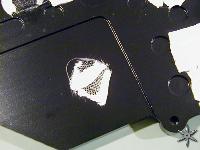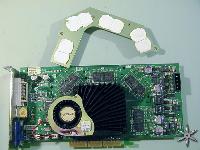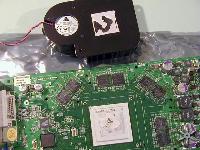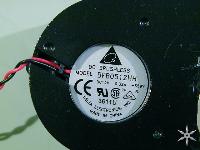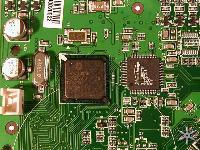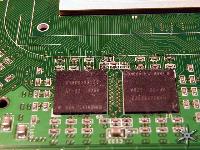After careful consideration I have decided to transfer all hardware review activities to a new domain. I purchased Hardwareasylum.com in 2012 and have been working hard to build a new and improved Ninjalane on that domain. If you are reading this you have reached one of the archived articles, news, projects and/or reviews that were left behind during the site migration.
Please update your bookmarks and be sure to visit the new and improved Ninjalane at Hardwareasylum.com
Gainward Ultra 1600XP GeForce FX 5900 Ultra Video Card Review
Author: Dennis Garcia
Published: Monday, September 01, 2003
Card Layout and Features
Even though this is a reference design card built by another company it still doesn't hurt to take a quick tour to see how it is built.
The first part to be removed is the memory cooler. The green part is very light and appears to be made from a folded piece of aluminum. The thermal pads seen in the photo correspond to the location of each memory chip pair and cooling fin. The heatsink on the back of the card is very solid and much to my dismay does not make direct contact with the backside of the GPU.
The first part to be removed is the memory cooler. The green part is very light and appears to be made from a folded piece of aluminum. The thermal pads seen in the photo correspond to the location of each memory chip pair and cooling fin. The heatsink on the back of the card is very solid and much to my dismay does not make direct contact with the backside of the GPU.
The thermal pads are quite thick and are composed of a fiber mesh filled with thickened thermal paste, as you can see they also come apart quite easily. Based on their thickness I suspect the pads are designed to cushion the memory with efficient thermal transfer being an afterthought. Temperature readings do show that they are working, kind of.
The cooling fan and heatsink will take up the adjacent PCI slot on your motherboard. The fan is made by delta and uses a squirrel cage blower to provide the airflow. As you can see the gum style TIM that didn't come off very cleanly but was removed and replaced with an application of Arctic Silver 3.
The cooling fan and heatsink will take up the adjacent PCI slot on your motherboard. The fan is made by delta and uses a squirrel cage blower to provide the airflow. As you can see the gum style TIM that didn't come off very cleanly but was removed and replaced with an application of Arctic Silver 3.
It should be noted that the fan has two modes of operation, namely low and high speed. The fan will spin at full speed while the computer is booting and changes to a lower RPM once Windows has started to load. I should also mention that the fan is supposed to spin faster when the 3d mode kicks in. The only problem is that during testing it never spun any faster so I suspect that the fan RPM is related to temperature and the GPU just never got hot enough.
With the cooling gear removed we can turn our attention to the various chips that make up the 5900 Ultra. Here we have the video processing chips, the Philips chip controls the VIVO s-video connection. The link is provided for more information.
http://www.semiconductors.philips.com/pip/SAA7108AE_V1.html
The Silicon Image chip controls DVI output, no other information could be acquired via their website.
The Silicon Image chip controls DVI output, no other information could be acquired via their website.
The memory chips are quite amazing. These chips are made by Hynix and support speeds of up to 500Mhz DDR at 2.8v. The CAS is programmable so timings and speed can vary based on the desired application. Considering the voltage needed to run at the default 2x425Mhz this and any 5900 Ultra should be able to run at 500Mhz DDR without any problem. For more info check out the Hynix memory spec http://www.hynix.com/datasheet/pdf/dram/(1)HY5DU283222AF(Rev.0.3).pdf

